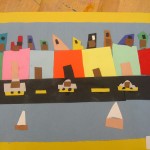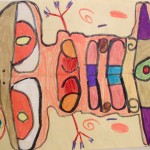Written by Lindsay Horbatuck in Sculpture 1
“The Impact of Art on Children”
The funding for many school districts is being cut dramatically which then means many schools are cutting programs they find unnecessary. One of the of the first programs that are being cut are the arts. I am currently in the process of being certified to be an elementary education teacher, and I will also be certified to teach ESL (English as a Second Language). In my education philosophy I focus on the idea that it is vital for there to be integration of the arts into the classroom in order for students to get the most out of their learning. The arts allows students to learn without even realizing that they are learning. It also gives students the opportunities to do hands-on projects and be completely immersed in their schooling. For my artist interview I interviewed Mr. Bryce Snyder the elementary school art teacher at Kelly Elementary in Lewisburg, PA.
LH: First can you please tell me about your education background; where you went to school and what you studied?
BS: I went to Kutztown University and got my bachelors of science in art education and my concentration was in drawing. I am currently getting my master’s at Bloomsburg in curriculum instruction.
LH: Can you please explain more about the master’s in curriculum instruction.
BS: It primarily to fulfill my ACT 48 credits for certification but to be a curriculum coordinator at some point would be an ultimate goal especially with art where it is headed right now in our state. People are really concerned about there jobs and they don’t know if there are going to be cutting programs, so to have that as a backup is very important at this point.
LH: What do you do in this job as an elementary school art teacher? What is a typical day like?
BS: Duties as an art teacher; you have morning duties, afternoon duties, sometimes recess. There are other responsibilities in the building besides just teaching; teaching is the best part of my job. For the most part my schedule varies each day, but I usually have four classes each day for about an hour each. Some days are lighter with only three classes while other days I may have five classes, which gets a bit crazy. This is the first year that I am teaching all grade levels; kindergarten, first, second and third. We have two teachers in the building and we split some of our work. Our classes are very small, and as a school district we take pride in having classes that are around 18-20 students. It helps because the student’s need a lot of attention. I think the hardest part about being an art teacher is catering to each student’s needs. Art is a skill, it is tough to teach that skill to students that don’t have it. If they don’t have the skill level you have to plan or alter your approach so they can achieve what you want them to.
LH: Do you find that the most challenging part of you job; catering to every child’s needs?
BS: I think that individualized instruction and really giving the kids the chance to succeed. Ideally you want every project to turn out the way that you expected it to be, but that is not always the case. Especially if I’m working with the laptops and there may be 18 hands up at the same type and you are completely overwhelmed by the fact that you have to get around to all of those kids, that is one of the more challenging aspects of my job. I have to teach a skill and get around to every kid who needs help individually to the quality of work you expect them to do. At times it can be very rewarding because you see kids who don’t necessarily have the skill level that others do but they are achieving at the level of others; that’s one of the best parts of my job. We are blessed here at Lewisburg, to have laptops and our Superintendent is very pro-technonlogy. We have a Dragon Foundation that donates laptops and there working on getting IPADs now. Technology is very important especially in art in today’s society. I can’t take the kids on a museum tour in New York city, but having these laptops I can show them stuff.
LH: With the laptop, are they doing actual art the laptop or are they researching art history?
BS: Both, there are programs on laptops such as KidPix, which is an art program, and the students have laptop time in their specific classrooms that they can use these programs. They become very familiar with how to use the laptops. For example, in first grade we did a sea-scape and the kids learned about complementary colors, warm colors, cool colors and they kids made a piece of art on the laptops. Then in 1st and 2nd grade they get into desktop publishing using Microsoft Word, and finding images off Google and then make self-portraits. Then in 3rd grade the PTA donated money and we bought tripods, which the students used to make clay-mation animation videos.
LH: I feel like technology is integrated more into the art classroom than when I was in elementary school from the booming new hype over graphic design and art involving technology.
BS: Like you said, that is where art is going with graphic design and very technology based.
LH: Do you find that you do other collaborative projects with the teachers in Kindergarten, 1st, 2nd, and 3rd grade?
BS: As far as cooperating and co-teaching, we don’t do that much. Art time is usually when the teacher has their planning time. However I try on every lesson to integrate what the students are learning in their classroom. For example with the clay-mation movie the students had to create clay figures that are correct human proportions. At that time the students were learning about guess and check in math class, so what I had the students do was apply the information they were learning with their clay figures. I am constantly making connections because first it helps the teacher and second it helps me. This is because art programs are diminishing throughout the state, you have to cover yourself and show why you are marketable. Art is the prefect way to do this, because art is visual, can be hands-on and kinetic.
LH: One big skill is being able to integrate what the teachers are doing in the classroom, what do you think are other essential skills for an art teacher to have? And how do you feel that you acquired these skills?
BS: They have great training programs here at Lewisburg, they have a training session called APL. First year teachers have to take this course, which is provided by the district. It is basic skills that any teacher should know. How to structure you lesson plans, how to deal with discipline issues, just basic common sense core teachings straegies. Having that organization and structure is essential and necessary. Art, gym, and music don’t get the same recognition as other teachers get but we have to have the same skill set. We need the same teaching strategies that they use in the classroom.
LH: I know we just talked a lot about your art in the classroom, outside of the classroom do you do any art? Do you have any exhibitions?
BS: I absolutely do, I do a ton of art at home. Drawing is my concentration, but I do a lot of watercolors, and some oil. I have had some exhibitions at the Ole’ Forge Brewery in Danville. I don’t have the time to devote to that due to the fact that I am a teacher and that is my priority right now. I get summers off and that is when I devote time to my own artwork.
LH: When you got out of school do you go right into teaching or was there some down time between when you started in the school?
BS: I had no down time. I graduated in 2007 and then I applied for this job. I was very blessed to get this job. Being a teacher, I would have to say I am even more into my art now than before when I started teaching.
LH: Why do you think that is?
BS: I think it is because I need my own time to relax and do something that I enjoy with art for myself other than for someone else. I think that is the great thing about teaching is that you can do that, you have the opportunity to explore other passions.
LH: Do you have any specific themes that you focus on in your work?
BS: For the most part, it pertains to fly fishing and my passion for that sport. I am a nature guy, and I am always outdoors so I would say that is my centralized theme. In college I tended to do a lot of black and white nostalgic charcoal landscape and some portraiture.
LH: I know we talked about many schools are cutting the funding for art. Why do you think that it is essential for schools to keep art in schools?
BS: I am blessed to be in a district where the arts are very important. In my graduate class this summer I did a class on, “Why Teaching Creativity is Important”. You should check out Sir Kenneth Robinson, he does work on creativity and how it is being limited in the classroom and how it is affecting kids these days. It is said that the top ten cooperation’s that run the business world that we live in today’s number one aspect or quality that they are looking for in their employees is being a creative thinker. What better realm to teach that than in the art room. When people say, “Why get rid of art” I say that kids can come in here and be creative and do the hands-on stuff they are learning in the classroom. They can also use that left and right side of the brain to develop those skills that are lacking in a lot of kids now a days.
LH: I know that is has become a very big issue now. I have always been very creative and have been exposed to art my entire life. That is why I find it very important to being into the classroom because it stimulates the mind in a different way.
BS: Exactly, and the kids enjoy it, because there is so much standardized testing now. These kids are feeling more pressure, so to give them a setting where they can come in here and learn concepts they are learning in class but enjoy themselves and listen to music and have less structure than the regular classroom.
LH: I feel like sometimes the student’s don’t even feel like it is learning; there’ learning without knowing there learning.
BS: I would compete agree, and that is why I like teaching.
LH: Thank you very much for doing this interview with me. One last question, if any of my classmates or my professor would like to follow up with you, would that be okay with you?
BH: Of course.




